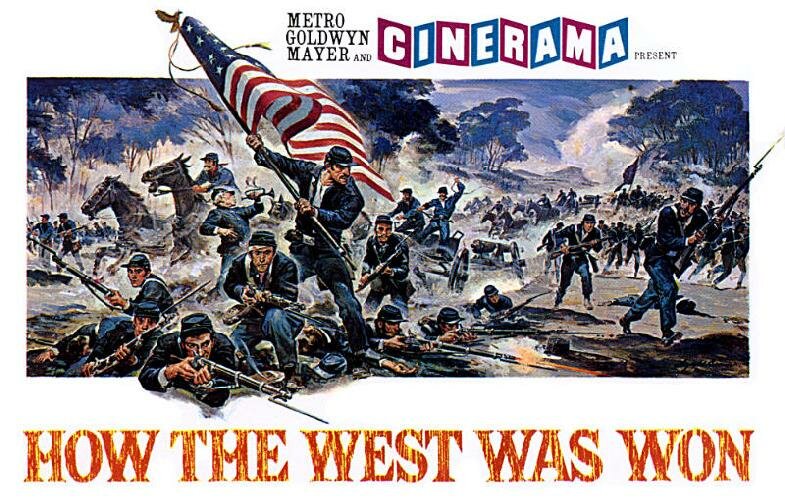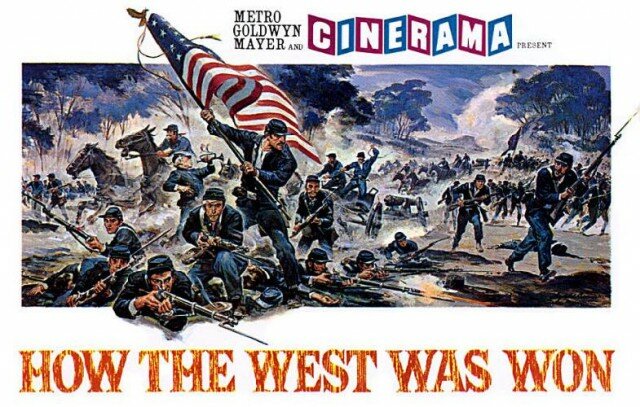In Sunset Boulevard (1950), Billy Wilder’s acid-refluxed love letter to Hollywood, Norma Desmond, a faded, reclusive silent film star, defiantly stands up and yells, “I am big! It’s the pictures that got small.”
That line must have stung Hollywood’s studio moguls. Less than a decade later, panicked by the sudden rise of television and declining theater attendance, Hollywood studios decided to put the hurt on old Norma. The pictures got big. Really big.
Beginning September 30 and running through October 16, the Cinerama Theater is presenting The Big Screen 70mm Film Festival.
They don’t make movies like this anymore.
In a day and age when consumers want content on the “best screen available,” we’ve gotten accustomed to watching films on iPhones, iPods and iPads. And that’s all well good if the movie is some piece of nothing, say Bridesmaids, that wasn’t designed with the big screen in mind.
But the fourteen 70mm films and two three-strip Cinerama movies in this festival won’t, you know, fit really well on an iPad. For these films, the best screen available is the Cinerama’s massive, deeply curved screen that is usually in storage and only pulled out for festivals.
If you haven’t seen Lawrence of Arabia or 2001 on this screen or this film size, you frankly haven’t seen them at all.
Hollywood Studio heads often overreact to new small screen technologies. In the 1950s and 1960s, studios tried 3D and massive screens to draw in the crowds. (Studios are trying the same tricks now, faced with competition from super small portable screens and super large flat screens at home. They haven’t figured out that good movies are the best draw.)
One of the first film technologies to push the image size was Cinerama (the theater is named after the film process, as is the Cinerama Dome in Los Angeles on, ironically, Sunset Blvd.). But camera and film technology hadn’t come up to the aspirations of the filmmakers. The process used three synchronized 35mm cameras filming scenes at one time from slightly different angles.
Three synchronized projectors in three different places in the theater then projected the finished films. That’s why the screen was curved.
Only eight films were produced in the 3-strip Cinerama format, and two of the best, This Is Cinerama and How The West Was Won, are on view for the Big Screen festival. Watching the films is a wild ride, since the borders where the three films meet can be seen. But it’s a wonderful spectacle. These movies look dreadful on DVD or, really, on any other screen.
Later, starting in the early 1960s, studios started using 70mm cameras in formats branded with names like Technirama, Super Panavision or Ultra Panavision.
70mm films had their heyday in the ’60s, and then the fad died out. (Ironically, because these films didn’t transfer well to TV. Before letterbox, they used pan-and-scan for the small screen, which is dreadful because you’d see someone talking to another person off-screen who was supposed to be on-screen).
So if you’ve been a fan of Chitty Chitty Bang Bang or the Sound of Music or My Fair Lady on TV or on VHS or DVD, you are in for a treat. Because in full 70mm, they are much better films.
The reason is that savvy directors used the wide screen capabilities as a theme in their movies. When Kubrick filmed 2001, he wanted audiences to truly feel the loneliness and horrible isolation of being in space. Similarly, David Lean made the vast desert a character in Lawrence of Arabia.
So many directors, from Lucas to Spielberg and Scorsese, have said that Lean’s film is such a huge inspiration. As a viewer who has only seen it on TV, you’ve probably wondered why. See it in this festival, and you’ll get it. It’s breathtaking. Truly, the gem of this festival.
But there are other pleasures as well. Play Time, Jacques Tati’s masterpiece, is a window into fashions and conventions in the hip ’60s. The Mad Men guys must have taken a long look at this film. West Side Story is here. So is the original Tron, which is sure to sell out.
When Paul Allen bought the Cinerama many years ago, he said he wanted to preserve it and celebrate the large screen films it was built to show. He has updated the technology, preserved films (the copy of West in the festival is his own), and scheduled several big screen festivals. Thank you, Mr. Allen. We are, as a city, lucky to have you around.
The results of his dedication are easy to see. For all the IMAX and 3D theaters coming online in Seattle, the Cinerama is still the best theater in town to watch a film.
And this is the third major big screen festival the Cinerama has produced. The last two featured some very rare three-strip films like Search for Paradise and Windjammer. Sadly, these films have deteriorated to such an extent that they can no longer be shown. (Many of the 70mm prints used in this festival were hard to round up.)
There won’t be many more chances to see many of these films in the way they were intended to be seen.
Don’t miss this chance. The pictures won’t be this big again.

